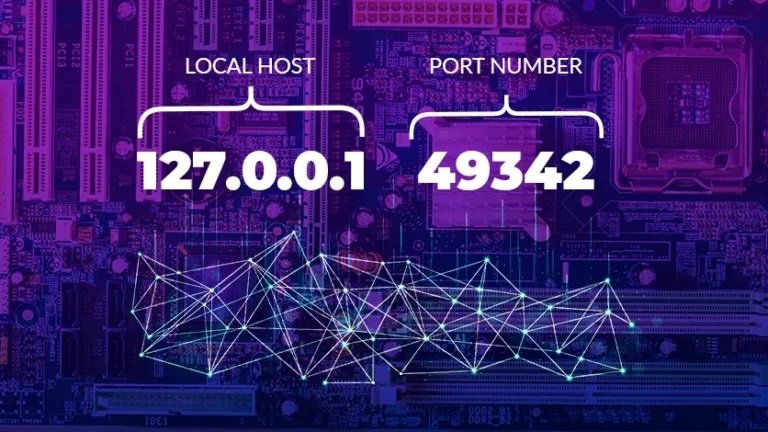Introduction to 127.0.0.1:49342
When working with web development or network configuration, you may come across terms like 127.0.0.1:49342. At first glance, this might look like a random set of numbers, but it holds significant meaning in networking and computing. Understanding 127.0.0.1 (commonly referred to as “localhost”) and port numbers, like 49342, is essential for anyone who deals with servers, networks, or even basic web development.
What is 127.0.0.1?
To understand 127.0.0.1:49342, we first need to break it down. 127.0.0.1 is known as localhost, an IP address that refers to your computer or device. It is a special-purpose address used in networking to allow a machine to communicate with itself.
Definition of Localhost
The term “localhost” refers to a loopback address, meaning it’s a way for your computer to send network requests to itself. Rather than reaching out to another computer on the internet, localhost is used for internal communications within your system. This is especially important for testing and development environments.
Importance in Networking
Localhost is critical for developers because it allows them to run web servers, databases, or applications locally without making them accessible to external networks. It acts as a safe, isolated environment where software can be tested before it goes live.
What Are Port Numbers?
While 127.0.0.1 refers to the machine, the number 49342 is a port number. In networking, a port number specifies a particular process or service running on a device. Think of it like a channel that directs traffic to the correct application.
Explanation of Port 49342
Port 49342 is an example of an ephemeral or dynamic port. These ports are assigned temporarily by the operating system for communication when a specific application starts a network connection. They range from 49152 to 65535 and are used by clients to connect to services like web servers, databases, or other networked applications.
Common Uses of Port Numbers in Networking
Port numbers are essential in managing network traffic. They allow multiple services to run on the same IP address without confusion. For example:
- Port 80 is typically used for HTTP (web traffic).
- Port 443 is used for HTTPS (secure web traffic).
- Higher ports, like 49342, are used temporarily for applications that need random, unique ports for a session.
How 127.0.0.1 Works
When you use 127.0.0.1, your machine is communicating with itself. This is used for local testing, where web developers, for instance, can run web applications on their computers before deploying them to the internet.
Localhost in Action
Developers often rely on localhost to test how their websites or applications function without exposing them to the internet. For example, if you’re building a website using Apache or Nginx, you can serve it locally by visiting 127.0.0.1 in your browser.
Loopback Functionality
Loopback functionality means that any data sent to 127.0.0.1 is immediately received back by your system. It’s a quick way to test networked applications in isolation.
The Role of Port 49342 in Localhost Communication
Ports are crucial in localhost communication because they help direct the traffic to the correct service. When you see 127.0.0.1:49342, the IP address (127.0.0.1) is directing the traffic to your local machine, while the port number (49342) tells the machine which specific service or application should handle the communication.
Understanding Port Assignments
When you start a web server or application locally, the system assigns it a port number. In this case, 49342 is the unique port your system has assigned to a specific service. This allows multiple services to run simultaneously on the same machine without conflict.
Why Port 49342? Randomized Ports Explained
Port numbers like 49342 are randomly assigned from a dynamic range. Operating systems use these ports when no specific port is requested by the application, helping to avoid port conflicts.
How Localhost and Ports Are Used in Web Development
For developers, localhost and port numbers are essential for building, testing, and running applications in a controlled environment.
Testing Web Applications Locally
Developers can run web applications on localhost using a variety of tools like XAMPP or Docker, specifying different ports (such as 49342) to avoid conflicts and to test how applications handle network requests.
Running Servers on Localhost
Tools like Apache or Nginx allow developers to run servers locally. By accessing 127.0.0.1:49342, for example, they can view their web application running on a specific port, ensuring that everything works as expected before deploying to a live environment.
Examples of Applications Using 127.0.0.1 and Port Numbers
Many applications use localhost for internal communication or testing:
Web Servers (Apache, Nginx)
These servers often run on localhost, allowing developers to simulate a real server environment.
Databases (MySQL, PostgreSQL)
Databases are often configured to listen on localhost by default for security reasons, only allowing connections from the local machine.
127.0.0.1 and Networking Security
While localhost is generally secure, it’s essential to understand the potential security risks associated with port numbers like 49342.
Security Implications of Localhost
Since localhost is isolated from the internet, it provides a safe environment for testing. However, some services running on localhost can be exposed if they are not properly configured, making it critical to close unused ports and services.
Is Port 49342 Safe?
While port 49342 is a dynamic port and typically safe for temporary use, it’s important to monitor which services are running on open ports to prevent potential vulnerabilities.
Common Errors Related to 127.0.0.1:49342
Errors can occur when dealing with localhost and port numbers, often related to configuration issues or port conflicts.
Troubleshooting Connection Issues
If you encounter a “connection refused” error, it could mean that the service intended to run on port 49342 isn’t active, or the firewall is blocking the connection.
Port Conflicts and Solutions
If multiple applications try to use the same port, you may encounter a port conflict. To resolve this, assign a different port number to each service.
How to Check Active Ports on Your Machine
Knowing how to check which ports are active on your machine can help troubleshoot issues and monitor which services are running.
Using Command Line Tools
On Windows, you can use the command netstat -an to view all active ports. On Linux/Mac, lsof -i :49342 will show which service is using a specific port.
Understanding Open and Listening Ports
Ports in a “listening” state are awaiting incoming connections. Monitoring these ports can help you identify potential security risks or unnecessary services running on your system.
How to Change Port Numbers in Development
Sometimes you need to change the port number to avoid conflicts or to use a more standard port.
Assigning Different Ports
In most web development environments, you can configure the port manually in the application settings or configuration files (e.g., changing 49342 to 8080).
Avoiding Port Conflicts
Using ports within the dynamic range (49152–65535) for temporary services reduces the chances of conflict with standard port assignments.
Differences Between 127.0.0.1 and Other IP Addresses
127.0.0.1 is a unique IP address, but how does it differ from external or public IP addresses?
Comparing Localhost and External IPs
While 127.0.0.1 is used internally, external IP addresses represent a device on a network. Localhost traffic stays within your device, while external IPs interact with other devices over the internet.
Private vs. Public IP Addresses
Private IPs (such as 192.168.1.1) are used within local networks, while public IPs connect devices to the internet. Localhost is unique in that it doesn’t leave your device at all.
127.0.0.1 in Cybersecurity
Localhost is generally secure, but it’s still important to take precautions, especially when running sensitive applications locally.
Protecting Your Localhost Environment
Ensure that services running on localhost are properly configured, and avoid exposing them to external networks unless absolutely necessary.
Common Attacks and How to Mitigate Them
Some attackers target misconfigured ports or services on localhost, so it’s important to close unused ports and keep your system updated to prevent exploitation.
When Should You Use 127.0.0.1 in Development?
127.0.0.1 is most useful in development environments, allowing you to test and build applications in isolation.
Local Testing vs. Live Environments
Local testing on localhost provides a safe space for debugging and refining applications before deploying them to a live server where they will be accessible to the public.
Benefits of Isolated Development
Working with localhost allows developers to make changes without affecting the live environment, ensuring smoother development cycles.
The Future of Localhost and Port-Based Networking
As technology evolves, so too does the use of localhost and port numbers.
Advancements in Local Server Development
With the rise of Docker and other containerized environments, developers are using localhost more than ever to create isolated environments for testing.
How IPv6 Impacts Localhost Usage
While IPv4 uses 127.0.0.1 for localhost, IPv6 uses ::1. As the world shifts towards IPv6, we’ll see similar concepts applied with new addressing formats.
Conclusion
127.0.0.1:49342 represents the backbone of local networking and development, allowing services to run in isolation on your machine. Understanding how localhost and port numbers work is crucial for anyone involved in networking, programming, or system administration. By knowing how to troubleshoot, configure, and secure these elements, you can create efficient and safe development environments.
FAQs
- What is 127.0.0.1:49342? It’s an IP address and port combination where 127.0.0.1 represents localhost (your machine) and 49342 is a dynamic port used by a service or application.
- What is the role of a port number like 49342? Port numbers direct network traffic to the correct service or application on a device, allowing multiple services to run simultaneously.
- How can I check which port is in use? You can use command-line tools like
netstatorlsofto see active ports on your system. - Is localhost secure? Yes, localhost is generally secure as it doesn’t expose services to the internet. However, misconfigurations can lead to vulnerabilities.
- Can I change the port number in localhost? Yes, most applications allow you to manually assign port numbers to avoid conflicts or to use more standard ports.
Also, Read, Verizentech: Your Partner in Cutting-Edge Technology Services.




